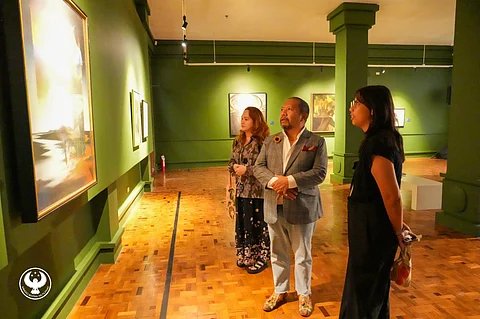
- NEWS
- the EDIT
- COMMENTARY
- BUSINESS
- LIFE
- SHOW
- ACTION
- GLOBAL GOALS
- SNAPS
- DYARYO TIRADA
- MORE

Apart from providing policy directions in the areas of banking, credit and money, the Bangko Sentral ng Pilipinas (BSP) safeguards some of the country’s assets, and among them is art.
Most of these art pieces, including old currencies and other artifacts, are housed in BSP’s own museum in Roxas Boulevard, Manila.
Unknown to many, the BSP has also been collecting not only masterpieces by the country’s National Artists. The institution also has in its vaults works by some of the country’s top and up-and-coming contemporary artists.
Art, according to BSP’s Sophia Mae Pelagio, is both a cultural asset and a mirror of society.
“Art holds stories of the past. It does not exist in isolation and evolves with society, reflecting and reshaping how we see the world,” BSP added in a statement.
As such, the BSP recently unveiled some pieces from its contemporary art collection and house them at the Galleries 18 and 19 of the National Museum since there is no more space at the BSP Museum, Pelagio told DAILY TRIBUNE.
Titled Kultural, Kapital, Kasaysayan: Contemporary Art from the BSP Collection, the exhibitions aim to showcase works that capture the dynamic interactions of culture and artists as creative capital.
“So for Gallery 18, we have here works by artists that depict or show everyday realities and lived experiences,” Pelagio explained.
At this gallery, BSP Deputy Governor Bernadette Romulo-Puyat was especially drawn to “Quiapo,” a 1976 oil on canvas by Mario Parial.
Gallery 19, meanwhile, displays artworks that serve as catalysts for dialogue, BSP’s Lauro Delos Santos told DAILY TRIBUNE.
Among the notable pieces from both galleries 18 and 19 are works by renowned contemporary artists like Geraldine Javier, Antipas Delotavo, Danilo Dalena and Roberto Chabet, the first director of the Cultural Center of the Philippines.
Apart from paintings, the exhibits also feature sculptures such as Junyee’s 2008 wood paint and ink “Ayaw Ko,” a funny depiction of a Filipino naked man seemingly ashamed of his private part and Uncle Sam tattoo at the back.
The galleries are now on view for free at the third floor of the National Museum of Fine Arts in Manila.
“Today, artists continue to push boundaries, blending diverse media to explore identity, ‘glocalized’ culture, gender, cultural integration, sustainability and technology,” BSP affirmed in its statement.
“Contemporary art deconstructs canons, revealing the complex legacies of the past, sparking critical reflections and powerful responses. In all its forms, Philippine contemporary art captures pivotal moments of change, continuously expanding the national consciousness.”
